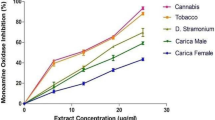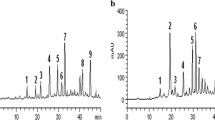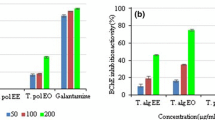Abstract
Despite the well-established medicinal values of Jimson weed (Datura stramonium L.), this medicinal plant has been associated with neurological effects such as hallucination and anxiety in folklore. This study examined the effect of alkaloid extracts from the leaf and fruit of Jimson weed on critical enzymes of the monoaminergic [monoamine oxidase (MAO)] and cholinergic [acetylcholinesterase (AChE) and butyrylcholinesterase (BChE)] systems of neurotransmission. Alkaloid extracts were prepared by solvent extraction method and their interaction with the activities of MAO, AChE, and BChE were assessed (in vitro). Gas chromatography coupled with mass spectroscopic (GC-MS) characterization of the extracts was also carried out. The results revealed that the extracts inhibited the activity of the enzymes assayed for in a concentration-dependent manner. Considering the IC50 values, the fruit extract had more potent (P < 0.05) inhibitory effect on the enzymes’ activities, compared to the leaf extract. GC-MS characterization revealed the presence of atropine, scopolamine, amphetamine, 3-methoxyamphetamine, 3-ethoxyamhetamine cathine, spermine, phenylephrine, and 3-piperidinemethanol, among others in the extracts. The alteration of activities of these critical enzymes of the cholinergic and monoaminergic signaling may be responsible for the reported neurological effects of this medicinal plant in folklore; nevertheless, the fruit extract exhibited more neuromodulatory effect than the leaf.



Similar content being viewed by others
References
Adegoke SA, Alo LA (2013) Datura stramonium poisoning in children. Nigerian J Clin Prac 16(1):116–118
Altameme HJ, Hameed IH, Kareem MA (2015) Analysis of alkaloid phytochemical compounds in the ethanolic extract of Datura stramonium and evaluation of antimicrobial activity. Afri J Biotechnol 14(19):1668–1674
Boyer EW, Shannon M (2005) The serotonin syndrome. New England J Med 352:1112–1120
Changeux JP (2010) Allosteric receptors: from electric organ to cognition. Annual Rev Pharmacol Toxicol 50:1–38
Çokuğraş AN (2003) Butyrylcholinesterase: structure and physiological importance. Turk J Biochem 28(2):54–61
Cometa MF, Fortuna S, Palazzino G, Volpe MT, Salgado ER, Nicoletti M, Tomassini L (2012) New cholinesterase inhibiting bisbenzylisoquinoline alkaloids from Abuta grandifolia. Fitoterapia 83(3):476–480
Dhawan K, Dhawan S, Sharma A (2004) Passiflora: a review update. J Ethnopharmacol 94:1–23
Fisar Z (2012) Cannabinoids and monoamine neurotransmission with focus on monoamine oxidase. Prog Neuropsychopharmacol Biol Psychiatry 38:68–77
Funada M, Aoo N, Wada K (2014) Rewarding effects of N-methyl-1-(4-methoxyphenyl)-2-aminopropane (PMMA) in mice: role of modifications of dopamine system mediated through its monoamine oxidase inhibition. J Addict Res Ther 5(172):2
Gashawa A, Getachew T (2015) The chemistry of khat and adverse effect of khat chewing. ASRJETS 9(1):35–46
Giacobini E (2003) Cholinergic function and Alzheimer’s disease. Int J Geriatr Psychiatry 18(S1):S1–S5
Green AL, Haughton TM (1961) A colorimetric method for the estimation of monoamine oxidase. Biochem J 78:172
Halpern JH (2004) Hallucinogens and dissociative agents naturally growing in the United States. Pharmacol Therapeu 102(2):131–138
Harborne JB (1998) Phytochemical methods: a guide to modern techniques of plant analysis. 3rd edn. Chapman and Hall, London, p 302
Herraiz T, Chaparro C (2005) Human monoamine oxidase is inhibited by tobacco smoke: β carboline alkaloids act as potent and reversible inhibitors. Biochem Biophysic Res Comm 326(2):378–386
Herraiz T, Gonzalez D, Ancin-Azpilicueta C, Aran VJ, Guillen H (2010) Beta-carboline alkaloids in Peganum harmala and inhibition of human monoamine oxidase (MAO). Food Chem Toxicol 48:839–845
Mack A, Robitzki A (2000) The key role of butyrylcholinesterase during neurogenesis and neural disorders: an antisense-50 butyrylcholinesterase-DNA study. Prog Neurobiol 60:607–628
Maheshwari NO, Khan A, Chopade BA (2013) Rediscovering the medicinal properties of Datura sp.: a review. J Med Plants Res 7(39):2885–97
Mairura FS, Setshogo MP (2008) Datura stramonium L. [Internet] Record from PROTA4U. In: Schmelzer GH, Gurib-Fakim A (ed) PROTA (Plant Resources of Tropical Africa/Ressources végétales de l’Afrique tropicale), Wageningen, Netherlands. <http://www.prota4u.org/search.asp>. Accessed 28 October 2015
McCabe-Sellers BJ, Staggs CG, Bogle ML (2006) Tyramine in foods and monoamine oxidase inhibitor drugs: a crossroad where medicine, nutrition, pharmacy, and food industry converge. J Food Comp Anal 19:S58–S65
Miraldi E, Masti A, Ferri S, Barni Comparini I (2001) Distribution of hyoscyamine and scopolamine in Datura stramonium. Fitoterap 72:644–648
Nunes B, Carvalho F, Guilhermino L (2003) Characterization of total head cholinesterases of Gambusia holbrooki (mosquito fish) and the assessment of effects induced by two environmental contaminants. J Vet Pharmacol Therapeut 26:260–261
Oboh G, Olasehinde TA, Ademosun AO (2014) Essential oil from lemon peels inhibit key enzymes linked to neurodegenerative conditions and pro-oxidant induced lipid peroxidation. J Oleo Sci 63(4):373–381
Perry NS, Houghton PJ, Theobald A, Jenner P, Perry EK (2000) In-vitro inhibition of human erythrocyte acetylcholinesterase by Salvia lavandulaefolia essential oil and constituent terpenes. J Pharm Pharmacol 52(7):895–902
Rodrigues SR, Caldeira C, Castro BB, Gonçalves F, Nunes B, Antunes SC (2011) Cholinesterase (ChE) inhibition in pumpkinseed (Lepomis gibbosus) as environmental biomarker: ChE characterization and potential neurotoxic effects of xenobiotics. Pesticide Biochem Physiol 99(2):181–188
Santillo MF, Liu Y, Ferguson M, Vohra SN, Wiesenfeld PL (2014) Inhibition of monoamine oxidase (MAO) by β-carbolines and their interactions in live neuronal (PC12) and liver (HuH-7 and MH1C1) cells. Toxicol In Vitro 28(3):403–410
Soni P, Siddiqui AA, Dwivedi J, Soni V (2012) Pharmacological properties of Datura stramonium L. as a potential medicinal tree: an overview. Asian Pac J Trop Biomed 2(12):1002–1008
Srivastava A, Shivanandappa T (2011) Differential cholinesterase inhibition in the rat brain regions by dichlorvos and protective effect of Decalepis hamiltonii roots. Neurotoxicology 32(6):931–934
Steenkamp PA, Harding NM, Van Heerden FR, Van Wyk BE (2004) Fatal Datura poisoning: identification of atropine and scopolamine by high performance liquid chromatography/photodiode array/mass spectrometry. For Sci Int 145(1):31–39
White SR, Obradovic T, Imel KM, Wheaton MJ (1996) The effects of methylenedioxymethamphetamine (MDMA, ecstasy) on monoaminergic neurotransmission in the central nervous system. Prog Neurobiol 49(5):455–479
Santillo MF (2014) Inhibition of monoamine oxidase (MAO) by α-ethylphenethylamine and N, α-diethylphenethylamine, two compounds related to dietary supplements. Food Chem Toxicol 74:265–269
Zhi K, Yang Z, Sheng J, Shu Z, Shi Y (2016) A peroxidase-linked spectrophotometric assay for the detection of monoamine oxidase inhibitors (Winter 2016–1). Iranian J Pharmaceut Res 15(1):131–139
Author information
Authors and Affiliations
Corresponding author
Ethics declarations
Funding
This research was not funded by any grant received by any of the authors.
Conflict of interest
The authors declare that they have no conflict of interest.
Ethical approval
All applicable international, national, and/or institutional guidelines for the care and use of animals were followed.
Rights and permissions
About this article
Cite this article
Ademiluyi, A.O., Ogunsuyi, O.B., Oboh, G. et al. Jimson weed (Datura stramonium L.) alkaloid extracts modulate cholinesterase and monoamine oxidase activities in vitro: possible modulatory effect on neuronal function. Comp Clin Pathol 25, 733–741 (2016). https://doi.org/10.1007/s00580-016-2257-6
Received:
Accepted:
Published:
Issue Date:
DOI: https://doi.org/10.1007/s00580-016-2257-6




